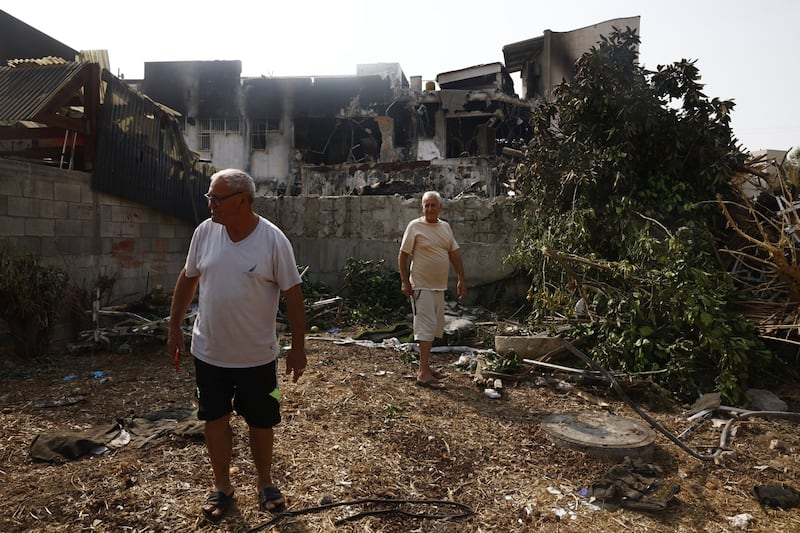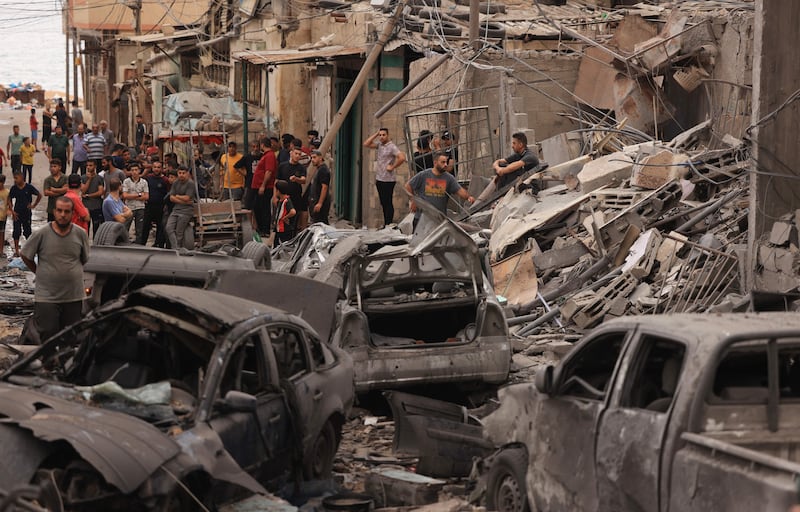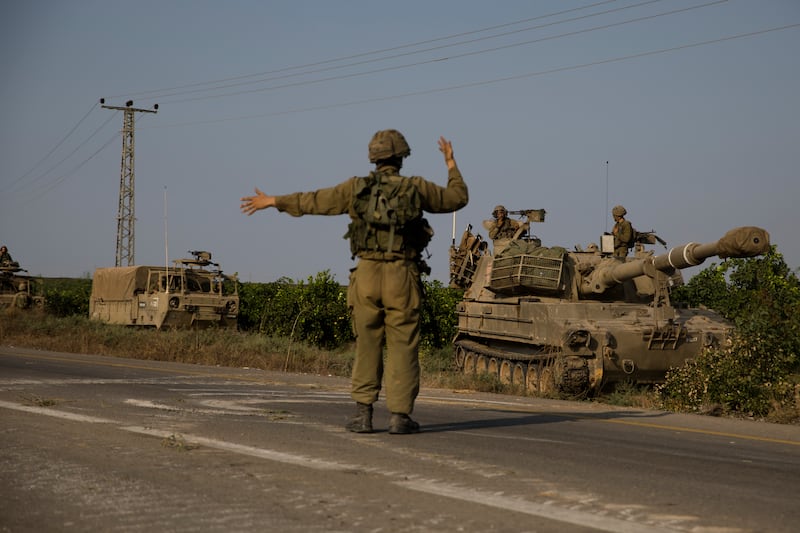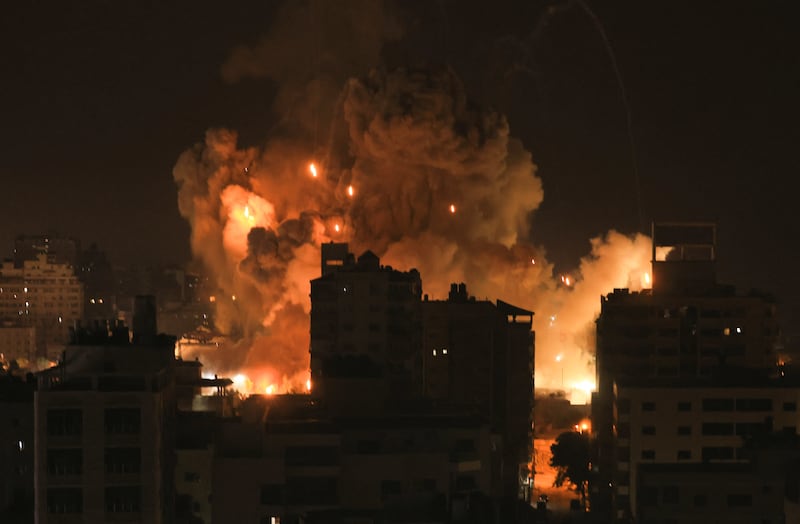What happened on the border between Israel and Gaza on Saturday?
Shocked Israelis woke on the last day of the Jewish high holidays to the wail of sirens as Hamas and Islamic Jihad fired thousands of rockets from Gaza and armed militants broke down the high-tech barriers surrounding the strip to enter Israel, shooting and taking hostages. Militants in boats also tried to enter Israel by sea.
It was a staggering and unprecedented offensive by Hamas and Islamic Jihad, and a catastrophic intelligence failure by Israel – and both will have long-lasting repercussions and consequences. The Israeli prime minister, Binyamin Netanyahu, declared that Israel was at war and that Palestinians would pay a heavy price.
Militants infiltrated Jewish communities near the border with Gaza, killing and seizing civilians and soldiers. Unverified videos showed terrified Israelis covered in blood, and with hands tied behind their backs, being taken by Palestinian gunmen. Many people rushed to safe rooms in their homes as the carnage unfolded around them.

Hundreds of young people at an all-night dance festival in southern Israel found themselves under fire. “They were going tree by tree and shooting. Everywhere. From two sides. I saw people were dying all around,” said one survivor. Authorities later said that 260 bodies had been recovered.
Gaza: Israeli strikes kill ‘at least 39 Palestinians’ and destroy medical supplies
Life in a Lebanese Palestinian camp: ‘We still don’t feel safe. At any time they may strike here as well’
United States steps up efforts to secure a ceasefire in Lebanon
‘Stop this horror of history,’ says President Higgins as Israel moves to ban aid agency
By nightfall on Saturday, the Israel Defence Forces (IDF) estimated there were still 200-300 Palestinian militants inside Israel. There were eight “points of engagement” where the IDF was trying to regain control from militants.
How did Israel respond?
Israel called up army reservists and launched a wave of air strikes on the tiny strip, which is home to 2.3 million people. Netanyahu warned Palestinians in Gaza to “get out of there now” as he vowed to reduce Hamas hideouts to “rubble”, but there is nowhere for those in the blockaded territory to escape to.
Warplanes targeted several buildings in the centre of Gaza City, including Palestine Tower, an 11-storey building that houses Hamas radio stations.

Israel has indicated it may launch a ground invasion, although this would carry huge risks both for IDF troops and for Israeli hostages being held in the territory.
Israel has cut off electricity and fuel supplies to Gaza, which may soon affect the strip’s medical facilities that are already under extreme pressure from people injured in the bombardment.
Video recorded in Gaza showed a mosque destroyed in Khan Yunis, in the southern Gaza Strip, and several large buildings in Gaza City in ruins.
Palestinians in Gaza shared images of text messages sent by the Israeli military to people in the Beit Hanoun area in the north of the strip that ordered them to leave their homes before the air strikes.
How many people have been killed and injured? And how many Israelis have been taken hostage?
At least 700 Israelis were killed and about 2,000 people were being treated in hospitals – 19 of them in critical condition – according to reports on Sunday.
The IDF spokesperson Daniel Hagari said more than 400 Palestinian militants had been killed in southern Israel and the Gaza Strip, and dozens more had been captured.
The Palestinian health ministry said that at least 400 Palestinians had been killed, including 20 children, and nearly 2,000 wounded as a result of Israeli air strikes in Gaza since Saturday. Seven people were also killed by Israeli army fire in the West Bank, including a child, it said.
Hamas has reportedly taken as many as 100 Israelis hostage – both soldiers and civilians, alive and dead.
Why did Hamas and Islamic Jihad launch the attack?
The exact reasons for the attack are not clear, but there has been growing violence for months between Israeli soldiers and settlers and Palestinians in the West Bank. Armed settlers have attacked Palestinian villages; militants in the West Bank have attacked soldiers and settlers, and there have been repeated IDF raids on Palestinian cities.
During the past week, some Jews have prayed inside the compound of al-Aqsa mosque in Jerusalem’s Old City. The area around the mosque is known to Muslims as Haram al-Sharif and is the third holiest place for Islam after Mecca and Medina in Saudi Arabia. To Jews, it is known as Temple Mount, and is venerated as the site of the biblical Jewish temple. Jews are not permitted to pray inside al-Aqsa compound; to do so is highly provocative. Hamas has called its current offensive Operation al-Aqsa Deluge.
The longer backdrop is a 16-year blockade of Gaza by Israel and Egypt that has almost destroyed the strip’s internal economy and has caused hardship for the people living there.

Extreme religious nationalists who are part of Israel’s right-wing coalition government have repeatedly called for the annexation of Palestinian territory. There has also been speculation that the offensive could have been encouraged by Iran as a means of scuppering moves by Saudi Arabia to normalise relations with Israel.
Why did the attack take Israel by surprise?
Hamas must have planned this offensive for many months, and it is a mystery why Israeli intelligence appears to have had no idea it was coming.
Israel’s surveillance of Gaza is intense. It monitors activity, communications and daily life via state-of-the-art surveillance equipment, including drones flying over the strip. It also relies on human intelligence via informants, many of whom are blackmailed or otherwise coerced into assisting Israel.
The intelligence failure is monumental, and will shake the Israeli public’s faith in their government and army’s ability to protect civilians.
“All of Israel is asking itself: where is the IDF, where are the police, where is the security?” said Eli Maron, a former head of the Israeli navy, on Channel 12. “It’s a colossal failure; the [defence] establishments have simply failed, with vast consequences.”
What does Hamas hope to gain?
The militant organisation that has ruled the Gaza Strip since 2007 has shown the world that it is a force to be reckoned with, but it is hard to see how there can be a positive outcome for Hamas or Gaza from the events this weekend.
Israel is likely to use the full force of its military might to crush militant activity, not just in Gaza but also the West Bank and East Jerusalem. In the process, a huge number of Palestinian civilians are likely to be killed, and homes and infrastructure destroyed.
The hostage-taking will also complicate Israel’s response and gives Hamas a significant bargaining chip. Gilad Shalit, an Israeli soldier held in Gaza by Hamas for five years, was finally released in 2011 in exchange for more than 1,000 Palestinian prisoners.
If Iran is involved, it will hope the violence will scupper any deal between Israel and Saudi Arabia.
Does Hamas have the support of ordinary people in Gaza?
Many people in Gaza just want to get on with their lives, free from the blockade and repeated wars and conflicts. They resent the restrictions imposed on them and the fear instilled in them by Hamas rulers.

However, others are driven to take up arms by the lack of hope and the misery that is characteristic of life in Gaza. They see militant action as the only way of asserting themselves and fighting for a better future.
Support for Hamas has not been tested since the last elections in Gaza in 2006.
What has been the international reaction to the Hamas offensive?
There has been overwhelming condemnation of Hamas and support for Israel’s right to defend itself. Joe Biden told Netanyahu that the US “stands with the people of Israel in the face of these terrorist assaults ... My administration’s support for Israeli’s security is rock solid and unwavering.”
The UN security council held an emergency meeting on Sunday to discuss the crisis. Meanwhile, UN peacekeeping forces have been deployed along the Lebanon-Israel border to “maintain stability and help avoid escalation”.
The Egyptian government said it was in talks with Saudi Arabia and Jordan to try to find a way to defuse the crisis. Egypt has been heavily involved in brokering ceasefires in the past. – Guardian



